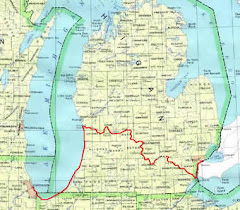
Continuing about whitewood dugout canoes:
In contrast to the Pottawatomie's, the Chippewas (Ojibwas) who occupied the more northern parts of Michigan, were expert birchbark canoe builders. Yet, when circumstances warranted, they chose to build dugouts. In 1864 a band was moving from the valley of the Thornapple River (a tributary of the Grand) to a new location considerably farther north and on the shore of Lake Michigan. They went into the woods a few miles away where they built a fleet of canoes from whitewood logs. The completed dugouts were hauled by wagon to the river. Some were as much as 40 feet long. This migration must have presented a scene much like the illustration by artist David Christofferson in the book "A Toast to the Fur trade" by Robert C. Wheeler.
In 1876 an old chief of this band traveled their route in reverse, going upstream on the Grand and Thornapple to his boyhood home at the mouth of a creek where he constructed a wigwam. He had come home to die and shortly thereafter he did.
In his 1888 book "Memorials of a Half-Century in Michigan", Bela Hubbard, an assistant to the renown Geologist Douglass Houghton, tells of a dugout procured from the Chippewa Indians in the fall of 1837 for a trip on Saginaw bay and Lake Huron:"It was a 'dug-out' of wood , thirty feet long, but so narrow that, seated in the centre, we could use a paddle on either side. In this puny craft we were to undertake, in the middle of autumn, a lake journey of 150 miles."
This was probably a whitewood dugout since we know from the account about the Thornapple band of Chippewas that they made canoes from whitewood logs and Tuliptrees did grow in the southern pat of the Saginaw Valley.
There are a number of references to dugouts on lower Michigan river systems, which, although not specifting that th canoes were whitewood, have been of interest to me because they were made and used in areas where Tuliptrees were plentiful.
In 1915 a massive four volume study was published which was entitled "A History of travel in America". Its author, Seymour Dunbar, after having described how an Indian canoe builder obtained and prepared a suitable log stated: "The log was shaped and hollowed by fire and cutting implements, and a very strong and serviceable though rough and slow moving craft was obtained." He then concluded: Such canoes were only adapted for lakes and single rivers".
He could have been describing the situation and needs in southern Michigan when settlers started arriving in the 1820s and 1830s. Those pioneers were primarily interested in a vessel's cargo carrying capability, not its portability. Likewise, the waters of their concern were the larger rivers that provided access to the Great Lakes such as the Grand, Kalamazoo and St. Joseph which empty into Lake Michigan, and the Saginaw River system which flows to Lake Huron.
NEXT: Sleek dugouts.


No comments:
Post a Comment